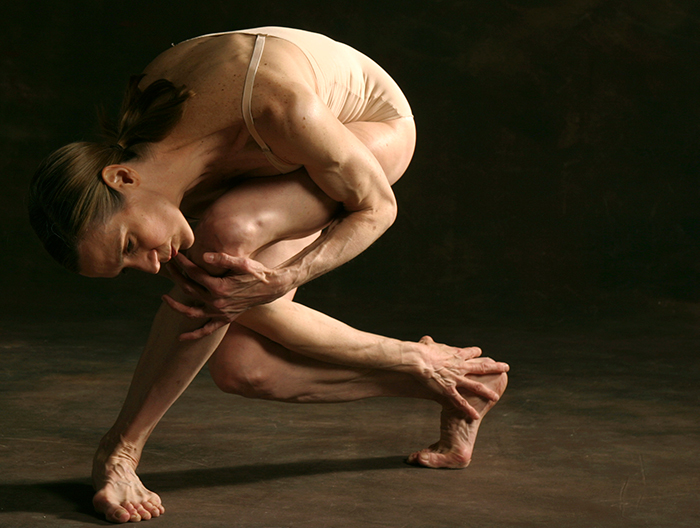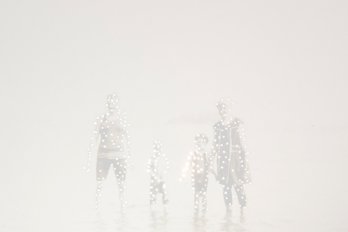
Two things strike you when Peggy Baker strides onto the stage: the long, angular lines of her sixty-year-old dancer’s body, and her loose yet careful composure. I first saw Baker in 2011, at an informal presentation at the Centre for the Arts in St. Catharines, Ontario. As she introduced Strand, a lyrical and realistic composition set to the haunting music of minimalist composer Ann Southam and inspired by the autobiographical writings of May Sarton, she spoke easily about the importance of being present during performance, while her eyes and hands conducted small routines to the music of her voice. She stood in the centre of a Persian carpet and moved her upper body in a series of familiar domestic gestures. Fingers covering her face: sadness. A quick hand flutter: joy. A lengthening and dropping of arms: heaviness. She distilled everyday gestures to their essence, revealing their inner poetry. At the close, she acknowledged the audience; we had collaborated, she said, by being present. And then she thanked us. Later I learned that her husband and collaborator, Ahmed Hassan, had died just two days earlier. For many years, and throughout their twenty-year marriage, the composer and musician had struggled with multiple sclerosis.
Baker has danced for nearly four decades now, and her solo career—which she embarked on at thirty-seven, an age when many of her peers retire—continues to test the limits of her chosen art form and her aging body. But how much further can she go? Dance needs a body—an able body, at that—to create. Over the past five years alone, in the course of teaching and rehearsing, she has broken her foot, partially dislocated a shoulder, and torn a quadriceps muscle. Watching Hassan lose his ability to move, says Baker, propelled her to keep moving: “One of the reasons I’ve danced this long is that I was married to a disabled person.”
For the first nineteen years of her life, Baker’s only dance experience was recreational. Growing up in Edmonton in the ’50s, she wore cotton gloves to her grandmother’s on Sundays. She and her peers were expected to assume traditional roles as mothers, teachers, secretaries, or clerks. Instead, she chose to study theatre at the University of Alberta, but dropped out after encountering Patricia Beatty, an acolyte of modern dance pioneer Martha Graham. Baker was captivated by Beatty’s dramatic demeanour, her feminist politics, and her poetic way of speaking. “When I discovered contemporary dance, I felt I had discovered something that was waiting for me,” she recalls. Soon after, she left Edmonton and moved to Toronto.
The Toronto dance scene in the ’70s was a fluid, mercurial environment where companies formed, drew choreography from a mix of modern vernaculars, performed, and sometimes disappeared. Baker began training in open drop-in classes, and within three years she and a handful of others formed Dancemakers, the Toronto company that would help define Canada’s burgeoning modern dance scene. It quickly became a group of “feisty performers [who] danced about ideas,” recalls fellow member Carol Anderson in Unfold: A Portrait of Peggy Baker, and it exhibited “a willingness to try new works, new spaces, new music and new collaborations.” By most accounts, Baker was a natural: both audiences and critics were overcome with her immense physicality and presence.
In the summers of 1979 and 1980, she attended workshops held by New York’s revolutionary Lar Lubovitch Dance Company. Struck by her intensity, and despite her minimal ballet training, Lubovitch invited her to audition. Baker declined; she was committed to Dancemakers. The next time he called, he offered to waive the audition. Again, she declined. The third time, he simply told her when rehearsals of his work would begin.
Baker does not have a petite ballerina’s body, but the idiosyncratic proportions of her long limbs and androgynous shape perfectly suited Lubovitch’s choreography, which often played with gender. Men danced lyric, sensitive roles, while women were cast in physical, fierce ones, and this androgynous approach contributed to Baker’s development as a dancer. But even as she performed lead roles on stages around the globe with one of New York’s most significant dance companies, she felt there was still something missing in her execution. It wasn’t enough to memorize choreography. She wanted to embody the movements, not just copy them.
In 1985, she attended a workshop by Irene Dowd on anatomy for dancers. Dowd, who had already developed a considerable reputation as a neuromuscular trainer, helped Baker deepen her understanding of her body’s movements from the inside out, and armed her with new knowledge of her neuromuscular and skeletal structure. She felt she no longer needed a mirror to watch and learn her routines. “My inner world took absolute precedence,” she recalls. “What things looked like was now a result of what was happening in the interior.” The seemingly arbitrary memorization of past choreography gave way to a system of embodied knowledge, and a new stage presence. Anna Kisselgoff, a dance critic for the New York Times, later remarked on Baker’s transformation, noting how she had “evolved into a dancer of striking physical projection.”
At thirty-seven, Baker began to consider retirement, but a season-long collaboration on the White Oak Dance Project with Mikhail Baryshnikov and Mark Morris changed her mind. Rehearsing with a company of elite dancers in studios on New York philanthropist Howard Gilman’s White Oak Plantation near Jacksonville, Florida, Baker and Baryshnikov shared a role, performing the same part on different evenings. Baryshnikov continued to dance despite his knee problems. Seeing how his interpretation differed from her own led Baker to an epiphany: dance needed representations of different bodies, movements, and abilities. For too long, the ideal body had been narrowly prescribed by ballet: young, athletic, poised, and perfect, it did not reflect the varieties of human experience.
In 1990, Baker returned to Toronto to pursue her solo career, and married Ahmed Hassan, who had been diagnosed with MS three years earlier. Trained as a percussionist, Hassan focused his music on rhythm and breath. He played the world’s earliest instruments—drums, gourds, and didgeridoo, among others—and had worked closely with the Toronto and Vancouver music and dance communities through the late ’70s and ’80s. The couple immediately began to collaborate and influence each other. Music constituted a spiritual practice for Hassan, and Baker felt the same way about her work: “Dance takes me into the absolute, distilled essence of my person. It takes me into a realm of learning and questioning.”
As a mature performer, she sought out choreographers who could push her artistically because their choreographic language was so different from her use of angularity, athleticism, and grace to embrace the limits of performance. In Montreal choreographer Paul-André Fortier’s remount of Non Coupable, she was blindfolded and tied down by rocks representing guilt, compulsion, and obsession. The physical weight of the role, coupled with blindness, forced her to access raw, troubling emotions. In turn, choreographers appreciated working with a member of a new, if older, generation. James Kudelka, the former artistic director of the National Ballet of Canada, remembers her as “ideal for choreographers who often had grown tired of dealing with generation after generation of dancers who never seemed to grow older.” Younger dancers might have had slight physical advantages, but they lacked experience. Baker had maintained her body through rigorous training and brought an intuitive wisdom to her dancing: she knew when to move and when to stay still. Her physicality, technical assurance, and enormous stage presence were “just plain inspirational to a generation of audiences who thought it was all over when youth faded,” recalls Kudelka. And yet her career cannot continue indefinitely. “I, as a persona onstage,” she says, “that’s going to be over in the next two years.”
Over the past decade, she has been entrusting dancers with her work, in a process she calls the Choreographer’s Trust, also explored in a two-DVD set. Video technologies may provide artifacts, but dancers have learned that films are unsatisfactory choreographic records. Baker’s approach involves intense week-long rehearsals with two dancers. She shares her understanding of the music, the choreography, and the aesthetic drive as each dancer learns the movements differently. Baker sees herself as a guide only; each performer must make the piece his or her own. By the end of the week, the dancers execute two distinct interpretations.
Future dancers will be able to watch segments of these performances and the process of their reconstruction. In a companion guidebook, Baker describes her inspiration for the pieces and the context of their creation, writing the same way she dances: intensely, with long, clear, simple lines. The Choreographer’s Trust requires Baker to separate the dance from her performances; she must become the choreographer while the new dancers uniquely inhabit the pieces. For Baker, this trust “refers both to the notion of a body of work as wealth that may be endowed, and also to the faith placed in the dancers to keep the works alive and well.”
On a cool September day at Canada’s National Ballet School in Toronto, a lithe Japanese dancer named Sahara Morimoto warms up to rehearse Geometry of the Circle, created and first performed by Baker and Hassan in 1993, six years after Hassan was diagnosed. Baker has been an artist-in-residence at NBS since 1992, where she conducts in-depth explorations of complex movement sequences, to teach her own students to dance from within rather than copying. As light pours in through two tall rectangular windows in a back corner of the studio, a bald man named Mark Brose wheels himself into the room, his wheelchair making loud squeaking noises as he turns on the floor, and is soon engaged in his own warm-up with a vocal coach. Baker walks lightly into the room, smiling, and animates the space as she embraces and chats with each of her collaborators.
Geometry of the Circle is a true duet; Brose’s primary means of expression is vocal, while Morimoto’s is movement. Brose wheels around the stage, making haunting chants, whistles, and mouth-popping sounds that search for Morimoto’s excited, often shy movements. They evoke the joy of courtship, finding each other even though their bodies speak different languages. Intense and beautiful, the duet closes with the vocalizer cooing to the dancer as she slowly and cautiously steps between the footholds of the wheelchair. As the dancer lowers her body to face him, the vocalizer issues a whispering set of plosives. Counterbalanced on his chair, she repeats the syllables.
Baker has them practise one sequence over and over, but Brose keeps forgetting his moves as he chases the spirited Morimoto around a turn. Finally, she asks, “Mark, what are you thinking about? ” He tells her he is remembering videos of Hassan performing the role. She listens patiently and then says, “Don’t think. Be the movement yourself.” Her four-decade career, distilled into two sentences, echoes the advice Hassan would give her, whether she returned elated after a performance or drained numb by rehearsal: “Dance who you are today.”
This appeared in the November 2012 issue.




